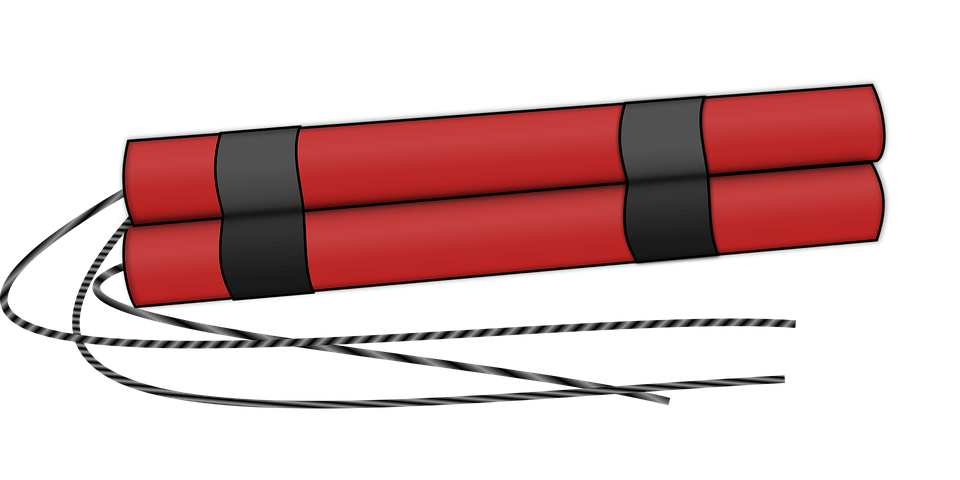What is the history and composition of dynamite? Information about the reactions, origin and uses of dynamite.

DYNAMITE is a powerful industrial explosive. It is widely used for underground coal mining, tun: neling, and other applications requiring small boreholes.
History
Dynamite was discovered and named by the Swedish chemist Alfred Nobel in 1867. Nobel found that when nitroglycerin, which is very sensitive to shock, was absorbed in diatomaceous earth it became less sensitive to shock and was less likely to explode from impacts encountered in handling and shipping. However, it eould still be readily exploded by a blasting cap. Because dynamite is both more powerful and less expensive, it quickly replaced black powder, which for centuries had been used both for blasting and gunpowder, as a blasting agent.
In 1875, Nobel recognized the need for a cohesive explosive that would detonate reliably underwater, and he gelatinized nitroglycerin by the addition of 7% nitrocellulose. “Blasting gelatin” is now little used in its original form, but it is a key ingredient of gelatin dynamite.
Composition
Modern dynamite is composed principally of glycerin-ethylene glycol nitrates, ammonium nitrate, sodium nitrate, and combustible pulps, such as wood meal, starch, rye flour, and sugarcane pith. It has a dry granular consistency.
Ethylene glycol nitrates are included in the formula because they form a low-freezing mixture with glycerin. Pure nitroglycerin freezes at 13° C (55° F), and when frozen, it is insensitive to a blasting cap. The mixture eliminates the hazard of a dynamite charge that fails to explode in cold weather.
Most dynamite is packaged in cylindrical paper cartridges ranging in diameter from 2 to 20 cm (0.8-8 inches) and in length from 20 to 91 cm (8-36 inches). Where the explosive needs to be used in long, rigid columns—for example, for generating earth vibrations in seismic prospecting— cardboard couplers are provided or the cartridges are made of plastic with threaded ends.
Reactions
In the detonation reaction, dynamite is converted essentially to carbon dioxide, nitrogen, and water vapor. The formation of poisonous carbon monoxide and nitrogen dioxide is kept at a safe level by a careful balance of the ratio of nitrates to pulps in those grades of dynamite intended for underground use.
The heat liberated by the explosion of dynamite amounts to 900 to 1,200 calories per gram, depending on the nitroglycerin content. With a high nitroglycerin content, the reaction produces a momentary pressure of almost 1,000,000 lb/sq inch (70,000 kg/sq cm) in a very intense shock wave that travels at a rate of several thousand feet per second. The resultant shattering effect is useful in breaking hard rock. On the other hand, a mixture of ammonium nitrate and pulps produces gas at a somewhat slower rate with a peak pressure near 60,000 lb/sq inch (4200 kg/sq cm); thus dynamite containing up to 80% of these ingredients is effective for mining coal in large pieces. Formulas high in ammonium nitrate and including some sodium chloride have been approved by the U. S. Bureau of Mines as “permissible” for use in coal mines because they produce a flame that is relatively brief and cool enough to avoid igniting a mixture of methane, coal dust, and air. Coal mine disasters have been relatively rare since permissible dynamite replaced black powder in mines.
Use with Other Blasting Agents
Dynamite is used to prime charges of nonnitroglycerin blasting agents that are more economical than dynamite for the large excavations required in the strip mining of coal, open-pit mining of metal ores, and rock quarrying. These agents are relatively safe in view of their insensitivity to mechanical impact or the explosion of a blasting cap. A reliable performance is assured by the use of a stick of dynamite with each charge.
A typical blast in such operations involves roughly 13,500 kg (30,000 lb) of explosive distributed among 25 to 50 large boreholes. If the holes are dry, they are loaded by blowing ammonium nitrate coated with fuel oil through a hose with compressed air. Where water is encountered, a “water gel” explosive may be used: it contains ammonium nitrate, TNT, or powdered aluminum, and 10% to 20% water gelatinized with a soluble gum. The use of nonnitroglycerin blasting composition is increasing.
mavi